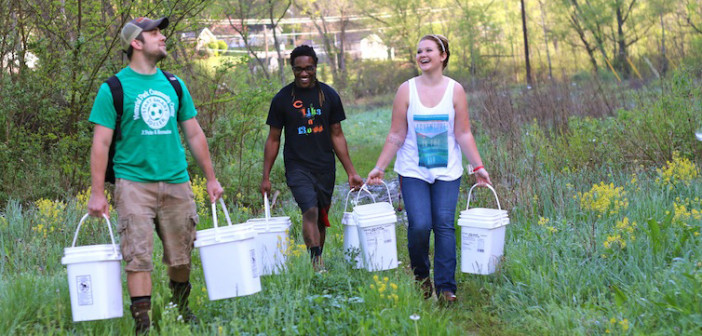By Jeff Keeling

ETSU students Nate Watts, Ta’Quan Johnson and Mattie Rogers haul mulch at Jacob’s Nature Park at Sinking Creek Saturday. Photos by Jeff Keeling
As the early morning sun burned away the mist Saturday, three college students trudged through the rushes just off King Springs Road, hauling buckets of mulch toward a precarious crossing point of Sinking Creek. It was just the kind of day, and just the location – abuzz with birds and insects, bursting with colorful plant growth – that sparks excitement in the typical 6-year-old.
The students were at the newly named Jacob’s Nature Park at Sinking Creek, a 28-acre city-owned tract of restored wetlands and steep wooded slopes whose development as a city park has been spearheaded by local attorney Bill Francisco, whose 6-year-old son Jacob died in 2004. Their destination was a one-mile loop trail that climbs the ridge on the creek’s south side, meandering past towering hardwoods, rock formations and wildflowers.

Kaitlynn and Kelton Cupples navigate the park’s current stream crossing, which will be replaced by a bridge.
Inspired by Johnson City Parks and Recreation Naturalist Connie Deegan, who had introduced them to the service opportunities available at the park, the hopes of Nate Watts, Ta’Quan Johnson and Mattie Rogers aligned with dozens of others who have volunteered time and energy to push the acreage toward something the public can learn from and enjoy for generations to come.
By year’s end, the park could include a bridge linking the wetlands to the woods, a first stretch of boardwalk through a section of wetland, and an outdoor classroom. All of these features will make the park – already in use by intrepid citizens and ETSU environmental science students, among others – a more accessible community asset than it currently is, City Commissioner Jenny Brock said Monday, four days after the commission officially named the park.
“I’m thrilled that we’ve had the leadership from Bill Francisco,” Brock said. “It’s cleaning up an area that really needed some attention that we hadn’t been paying any attention to.
“I think it will be a natural area that our students can study, that ETSU can study, and that it can become a destination where people will have a naturalist’s place to go and study. And it’s not real far from the Tweetsie Trail at all, so it’s all coming together.”
As the ETSU trio worked with Deegan spreading mulch Saturday, awaiting the arrival of many fellow students for a large-scale work day, Francisco saw off a cadre of cyclists and walkers from the west end of ETSU. They were riding and walking to raise funds for the park’s development, and doing so most directly because of the late Jacob Francisco.
Jacob Francisco died in mid-2004, his organs attacked by a shiga toxin-producing E. coli bacteria infection. The Franciscos live along Sinking Creek, upstream of the park, and while doctors never discovered the source of Jacob’s infection, the stream is considered unsafe for wading and irrigating in certain portions due to high E. coli levels.
For more than a decade, Bill Francisco has raised funds, primarily through Jacob’s Ride and Awareness Walk, for causes related to combatting or preventing waterborne infections and illnesses. For the past several years, those proceeds have collected in a special fund overseen by the Boone Watershed Partnership (BWP). (Learn more about the park project under the “building jacob’s nature park” tab at jacobfrancisco.com).
BWP’s grant-funded Sinking Creek restoration project, begun in 2008, was aimed at reducing stream pollution and included the enhancement and enlargement of wetlands, which help filter bacteria, at what is now the park property. After Francisco met BWP members, they combined forces to work toward the park’s completion. Deegan, enthused at the prospect of another place to lead educational treks, joined in a couple of years ago and has enlisted ETSU student volunteers for the trail development, trash removal and other important tasks.
Francisco said Saturday the proceeds from this year’s fundraiser should push the total in the BWP account past $30,000. Last week, he visited the park with local engineer Gary Tysinger, who suggested a revised location for the bridge. That structure was set to be funded and built by volunteers from a local Lowe’s store last fall, and Francisco said that’s still a possibility this year.
The first stretch of boardwalk could meander over the downstream or eastern portion of the wetlands, which teem with aquatic life, birds and insects, to a large willow.
As more city residents discover the park’s charms and it begins serving as a learning laboratory for younger students, ETSU will continue using it to study water quality and best management practices (BMPs) for achieving cleaner water. Dr. Phil Scheuerman, an environmental health professor, said both undergraduate and graduate students have studied the stream. One, doctoral student Chris Green, is using some of the funds from Francisco’s efforts to model the effectiveness of the wetland and other BMPs on water quality improvements.
When Green completes his initial analysis, he’ll present a written report to BWP this summer. Scheuerman said he believes the BMPs on Sinking Creek and also on Brush Creek, including at Founders Park, are proving effective.
“These are places for us to learn about the effectiveness of BMPs’ impact on streams, and it’s a great way to start early with young kids,” Scheuerman said. “These are the kinds of things that are going to be very positive for the city from an educational standpoint, a recreational standpoint and a water quality standpoint.”
Jacob’s Nature Park at Sinking Creek remains primarily privately funded. Tax deductible donations can be sent to Boone Watershed Partnership, 708 Allen Ave., Elizabethton, TN 37643, marked “Jacob’s Park” on the memo line, or online at boonewatershed.org.
The park has a small parking lot on the right side of King Springs Road, 0.55 miles east of the four-way stop at Legion Street and shortly before Rich Acres Freewill Baptist Church on the other side of the road.







